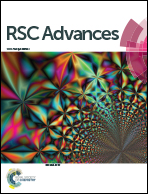Effect of Pt doping on the gas sensing properties of porous chromium oxide films through a kinetic response analysis approach†
Abstract
The effect of doping trace amounts of noble metals (Pt) on the gas sensing properties of chromium oxide thin films, is studied. The sensors are fabricated by depositing chromium oxide films on a glass substrate using a modified spray pyrolysis technique and characterized using X-ray diffraction, scanning electron microscopy, transmission electron microscopy and X-ray photoelectron spectroscopy. The films are porous and nanocrystalline with an average crystallite size of ∼30 nm. The typical p-type conductivity arises due to the presence of Cr vacancies, formed as a result of Cr non-stoichiometry, which is found to vary upon Pt doping. In order to analyze the effect of doping on the gas sensing properties, we have adopted a kinetic response analysis approach, which is based on Langmuir Adsorption isotherm (LA) theory. The sensor response is analyzed with equations obtained from LA theory and time constants as well as energies of adsorption–desorption are evaluated. It is seen that, Pt doping lowers the Schottky barrier height of the metal oxide semiconductor sensor from 222 meV to 172 meV. Subsequently the reduction in adsorption and desorption energies led to enhancement in sensor response and improvement in the kinetics of the sensor response i.e. the response time as well as recovery times of the sensor.


 Please wait while we load your content...
Please wait while we load your content...